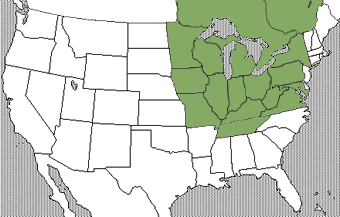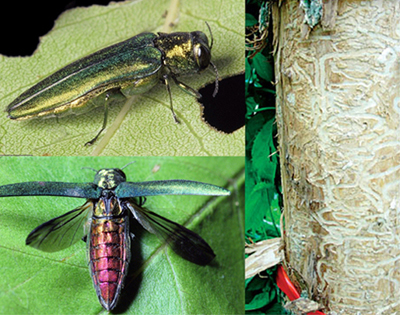This summer marks an anniversary of sorts. Shortly after I joined the faculty at Michigan State University in the fall of 1999 MSU Extension began to get reports of dead and declining ash trees in and around Detroit. Since ash trees had relatively few serious pest issues and none that routinely caused mortality, the mysterious ash decline was attributed to cumulative environmental stresses, ash yellows or various site factors. In the summer of 2002, however, a little-known exotic beetle from Asia, emerald ash borer (Agrilis planipennis) was identified as the causal organism. The beetle was so obscure that the first insects collected had to be sent to an entomologist in Eastern Europe for identification. The summer of 2002 has become a point demarcation for those that work in landscape horticulture or urban forestry in the Midwest and East; now it’s before EAB and after EAB. Prior to 2002, EAB was completely unknown in the US, today it has been identified in 15 states and 2 Canadian provinces.

EAB range June 2012
In the intervening 10 years we have learned a lot about the beetle. In fact, it seems likely that we have learned more about EAB in 10 years than just about any tree pest in history. I did a quick Google Scholar search and there have been nearly 600 articles published with ‘emerald ash borer’ in the title since 2002. Below are some highlights of what we’ve learned.
In lower Michigan, EAB is able to complete its life cycle in one year. Adults emerge in early summer, feed on ash tree foliage, mate, and lay eggs on ash tree bark. When the eggs hatch the larvae burrow into the tree and feed on phloem under the bark leaving extensive galleries. The larvae eventually pupate and overwinter before emerging as adults the next summer, leaving a characteristic D-shaped exit hole.

EAB life cycle – National Plant Gemplasm System
Host range. When EAB was first discovered very little was known about the insect, even in its native range in China and Korea. At the time, information from its native populations suggested that EAB could affect trees outside the genus Fraxinus. Research in the US, however, has clearly demonstrated that EAB adults can only feed on Fraxinus foliage and EAB larvae can only develop by feeding on ash tree phloem. So there is little likelihood that EAB will ‘make the jump’ to other tree species outside of Fraxinus. That’s the good news. The bad news is that all North American ashes are susceptible to EAB. There are some differences in relative susceptibility; green ash trees are probably the most susceptible, while blue ash trees will hang in there the longest. Eventually, though, all North America ashes will succumb.
How not to stop an exotic invasion. While much of what we’ve learned about EAB has been through systematic research, we have also learned by trial and error. Immediately after EAB’s discovery regulators decided the best approach was try to eradicate the pest. Historically eradication efforts have not been very successful but decision-makers at the time may have been buoyed by the recent successful eradication of Asian long-horned beetle in the Chicago area. To make a long story short, EAB eradication failed. In 2002 the EAB infestation was made up of a core population in and around Detroit and a series of isolated outlier populations. The eradication strategy was analogous to fighting a forest fire – build a perimeter around the main hot spot and eliminate outlying ‘spot fires’ as soon as they appear. With EAB the fire fighting analogy broke down for two reasons. First, it was impossible to contain the main population since the insect was continually carried out of the core area, largely by campers moving firewood (It’s a Michigan thing). Secondly, fire-fighters can rapidly respond to isolated spot fires because smoke identifies the location almost immediately. With EAB there is typically a 2-3 year lag period once the beetle moves into an area until trees begin to show symptoms. By that time the population is well established and has likely already spread beyond any potential containment.
Saving your ash. In 2002 there was no data on effectiveness of insecticides against EAB. Therefore researchers and extensions specialists, did not provide recommendations for arborists to control it. Several arborists ignored our advice and treated trees in the core infestation areas in Detroit with insecticides. In some cases those trees are still alive. So were the arborists right and were we wrong? I think both groups did what they had to do. As scientists and extension specialists we can’t make recommendations in the absence of data. In many cases the arborists took a ‘sledgehammer’ approach, using multiple products and multiple applications. They saved some trees but they probably used more chemical than they needed to and probably hit some beneficial and other non-target insects along the way. Today, with the benefit of nearly decade of research, we have effective controls for individual trees, primarily using trunk-injected systemic insecticides.
http://www.emeraldashborer.info/files/Multistate_EAB_Insecticide_Fact_Sheet.pdf
What’s next. The range of EAB continues to expand. While it is possible to protect individual trees, we need to remember those trees will require treatment in perpetuity to survive. The development of hybrid ashes – similar to what has been done with elms – seems like to most likely scenario that will get ashes back into the landscape. In the meantime, EAB joins chestnut trees and elms as another reminder of the need to diversify our landscape in order to reduce risks associated with exotic pests.
about 2-3 years ago I went to a talk from some people from MSU about EAB. They had mentioned a landscaper who guaranteed the ash trees to survive (in the Detroit area) if he treated them with his protocol. Sound familiar? This pest is now in several counties in Wisconsin and it seems that only arborists can/will be treating this insect with an expensive regimine of insecticides. I do not think the average homeowner has not grasped the destructive force this insect will cause on the landscape despite many publications/talks about it. I have advised clients and friends not to plant ash trees but that is only a drop in the bucket once ash trees (mine included) start declining. I believe more alternative trees to plant (not Norway maples!)need to be pushed onto consumers.
First–It’s not a Michigan thing: http://www.nps.gov/grsm/planyourvisit/firewood-alert.htm
Second–This sounds like a good reason to test “exotic” plants for their viability to maintain diversity in, at least, our urban forests.
Gail,
It is possible for homeowners to treat their own trees using soil drenches of imidacloprid (sold as Beyer Advance Tree and Shrub care). Although this works best on small trees and you might imagine. In terms of treating trees, we need to provide a ‘fair and balanced’ picture: It is possible and can be highly effective BUT it can be quite expensive and the tree will likely have to stay on the program forever. As you note, in the long run improving overall species diversity will be the key to reducing the likelihood of catastrophic tree loss like this.
Hi Shawn: I was being a little tongue in cheek – I’m sure campers bring loads of firewood with them in other states, too. It just struck me a couple of summers ago when my daughter and I stayed at a Forest Service campground in the Upper Peninsula and the campers next to us brought a utility trailer – just for their firewood! I like S’mores and roasting hot dogs as much as the next guy but really? On your second point I agree whole-heartedly.
We should be trying out all well-adapted trees (excepting invasives), native and exotic.
Spain has some problems with a similar insect exterminating palms: Phoenix canariensis.
My practice is based on no waste, no pollution, correct species for the urban ecoregion.
Excellent post, many articles of this type are unintelligible for most, even the initiated. Here what I do:http://www.associatedcontent.com/article/7741396/5_gardening_blogs_you_should_read.html?cat=32
http://www.guiaverde.com/blog/destacadas/jardin-tropical-en-puerto-rico
How often should the tree be treated, every year, or 2 years? should you change the kind of insecticide for on year to the next?
Bernard:
The EAB insecticide fact sheet I’ve linked above is the most authoritative and comprehensive guide. So far, emamectin benzoate (trade name TREE-age) is the most effective product available and can provide up to three years of control. I’m not an expert on insect evolution but the selection pressure for insecticide resistance is probably low since the proportion of trees that are treated is very small since there are millions of ash trees in native woodlots that are not treated.
Terrific post, Bert.
Please share your knowledge about the status of efforts to: 1. introduce insect species or other biocontrols that predate the EAB, and 2. evaluation of the degree of resistance to EAB of Asian (and European) Fraxinus spp. as well as Asian/N.American hybrids)
Dear Sonia:
There has been quite a bit of research on both areas you mentioned. Without being to much of a tease – I will address on my post on Monday. I am currently on vacation and my wife has threatened bodily harm if I don’t get off the computer!
Bert have you heard about the update on EAB from Green Bay. Wisconsin Public Service will be removing all ash (34-36 trees) on their property on Monday due to EAB. The borer found about 2-3 years ago was near their facility. The first major loss of ash tr
ees in Green Bay. While I was driving around I noticed that they have many mature ash trees-its going to be a big loss for the city in the next few years.